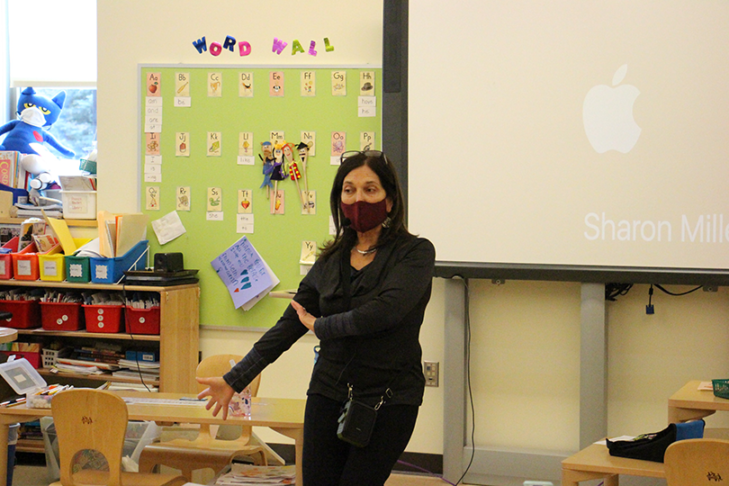We sat down with Sharon Miller to discuss what this year has been like, why she loves kindergarten and why we shouldn’t just think of kindergartners as cute.
Why kindergarten?
Kindergartners are so fresh and new. Their view of the world is so open. It’s absolutely refreshing and enlivening; they are so full of life. I love introducing them to a love of learning and nurturing the love they come in with. They love school. I feel this is the place to start developing relationships and understanding how important it is to treat other people. I love when a child learns to read; I love being part of their first reading experience, their first, “Aha! I get what these symbols on the page are.”
When did you start at Rashi?
Over 20 years ago!
What has been most different about this year?
Well, one thing that’s really different is that we don’t gather on the rug as a small, intimate group. That’s changed teaching a lot. We’ve found other ways to stay close and connected and I’m frankly surprised to see that even though the systems may be different, we are able to have [and achieve] the same end goal.
I’ve never taught with masks before; I never thought it would come so easily to kindergartners. We use technology more than ever. That has its pros and cons. The technology is helpful to have teachers be able to be remote when that was needed, but at the same time, there’s nothing like having a teacher right there with you. But we have learned how to do all kinds of meetings and as we’ve all become more aware of the possibilities that technology offers and better able to use it, experiment and explore with it, we’re able to find ways that children can use it, creating more options for them.
What kinds of options?
Using the activity boards is one option: kindergartners can try out or show a principle with blocks or math manipulatives. They can go do it with a material in the classroom, or with an activity board. We have increased our integration of apps to practice a concept that’s been taught or to delve a little deeper into a concept if that’s what a child’s needs are, or to reinforce skills and practice if that’s what the needs are.
What has stayed the same?
Kids are still able to get to know each other, interact, develop friendships, have conflicts from which they learn conflict resolution, that still happens even though we are not sharing as many materials. The developmental needs of kindergartners are similar in terms of how to work together and see different perspectives besides their own. We’re still very able to address that.
What do you want people to know about kindergarten?
This is a very serious time for beginning learning. Often kindergartners are seen as cute; at times people don’t realize the really hard work they put in to make these gains. Whether it’s learning how to write letters that are legible and convey an idea or learning how to communicate with someone else who has a really different idea of what they are trying to create in the block area, kindergartners are working. This is their job, just like we have jobs. They take great joy in their accomplishments and growth and experience the same frustrations. Sometimes it takes an extra little bit. I have tremendous respect for them, even if some days it’s hard for them. When people see their product and think it’s just cute, they don’t see the tremendous amount of work and progress they have made.
What’s a special unit you teach?
Diversity, equity and inclusion has always been near and dear to my heart. We have always taught about being respectful, being open to others, loving yourself while you also make yourself not feel better than others.
This year, as a part of Rashi Reads, we used Julius Lester’s book “Let’s Talk About Race” to encourage kindergartners to think about how to get to know someone by learning all of the parts of their story, e.g., I am a kindergartner, I might be light-skinned and I like to swim. Learning how to do that by including race in the story has been very exciting. We created self-portraits; students tried to make their own skin color, we’ve read more books by writers of color and listened to readers of color. It’s so important for them to be hearing different voices. They’ve had exposure to authors of color in their own voices.
Tell us about the teaching model in kindergarten.
We have a teaching team in two classrooms. I’ve had a chance to get to know the entire kindergarten in a way I haven’t known before; that’s been extraordinary. The three-teacher model has been exciting to share a lot of the responsibilities with my fellow kindergarten teaching team. It takes tremendous planning and coordination; it’s wonderful to have three minds planning together. People here at Rashi love teaching and love education. There is a tremendous commitment to teaching every kid who comes through and an openness to doing it all different ways.
This post has been contributed by a third party. The opinions, facts and any media content are presented solely by the author, and JewishBoston assumes no responsibility for them. Want to add your voice to the conversation? Publish your own post here. MORE


